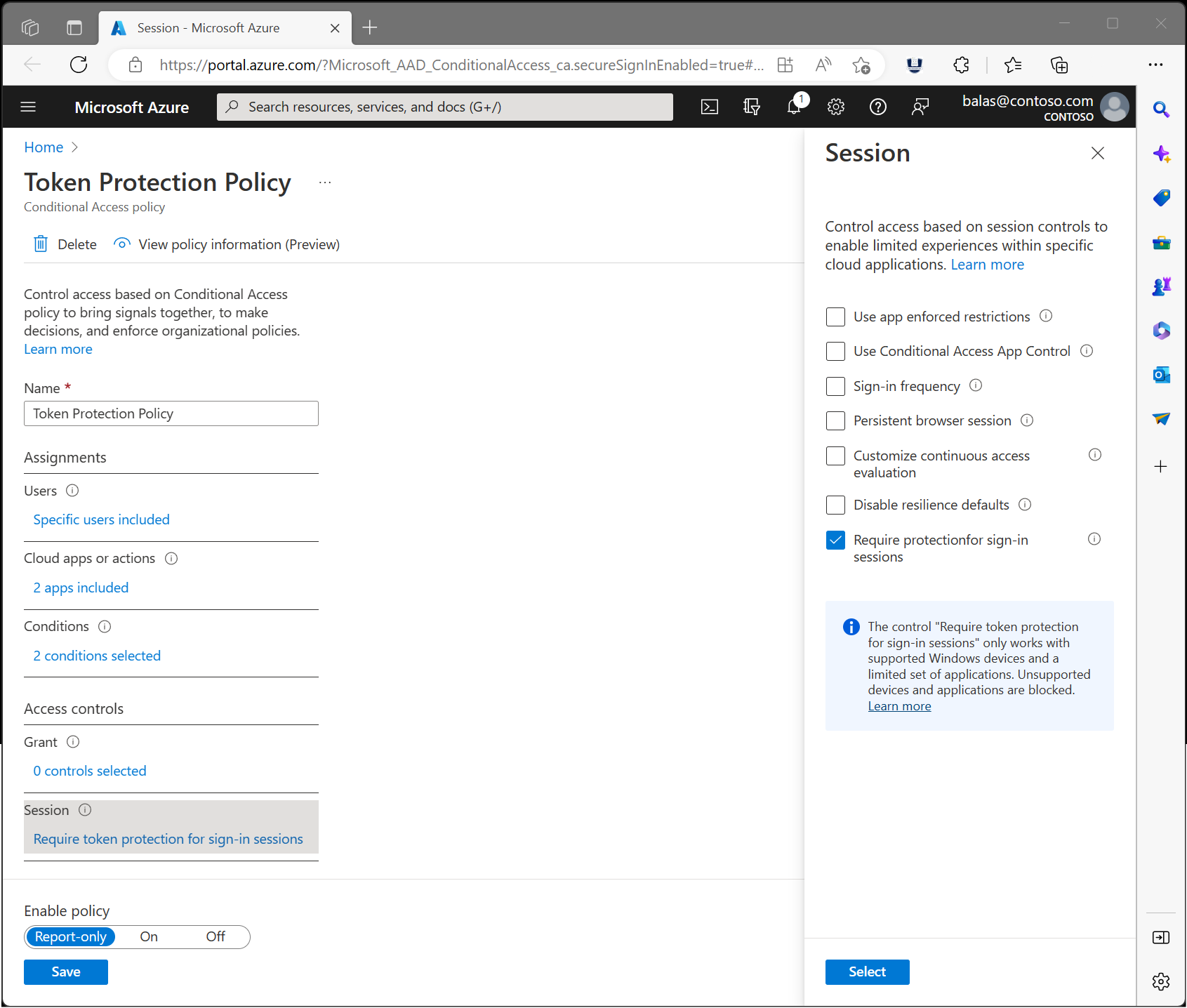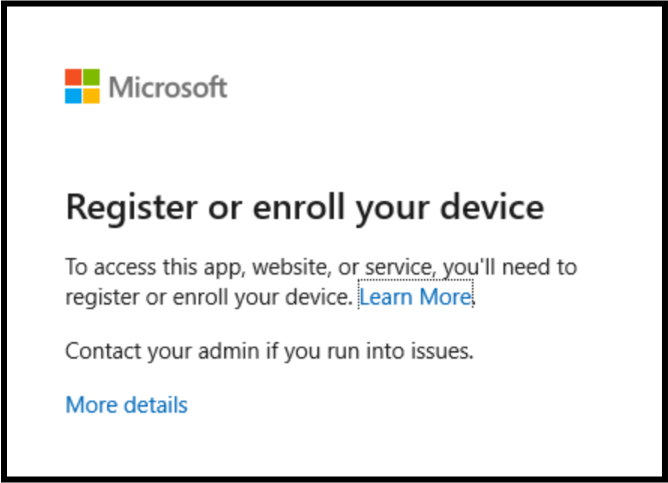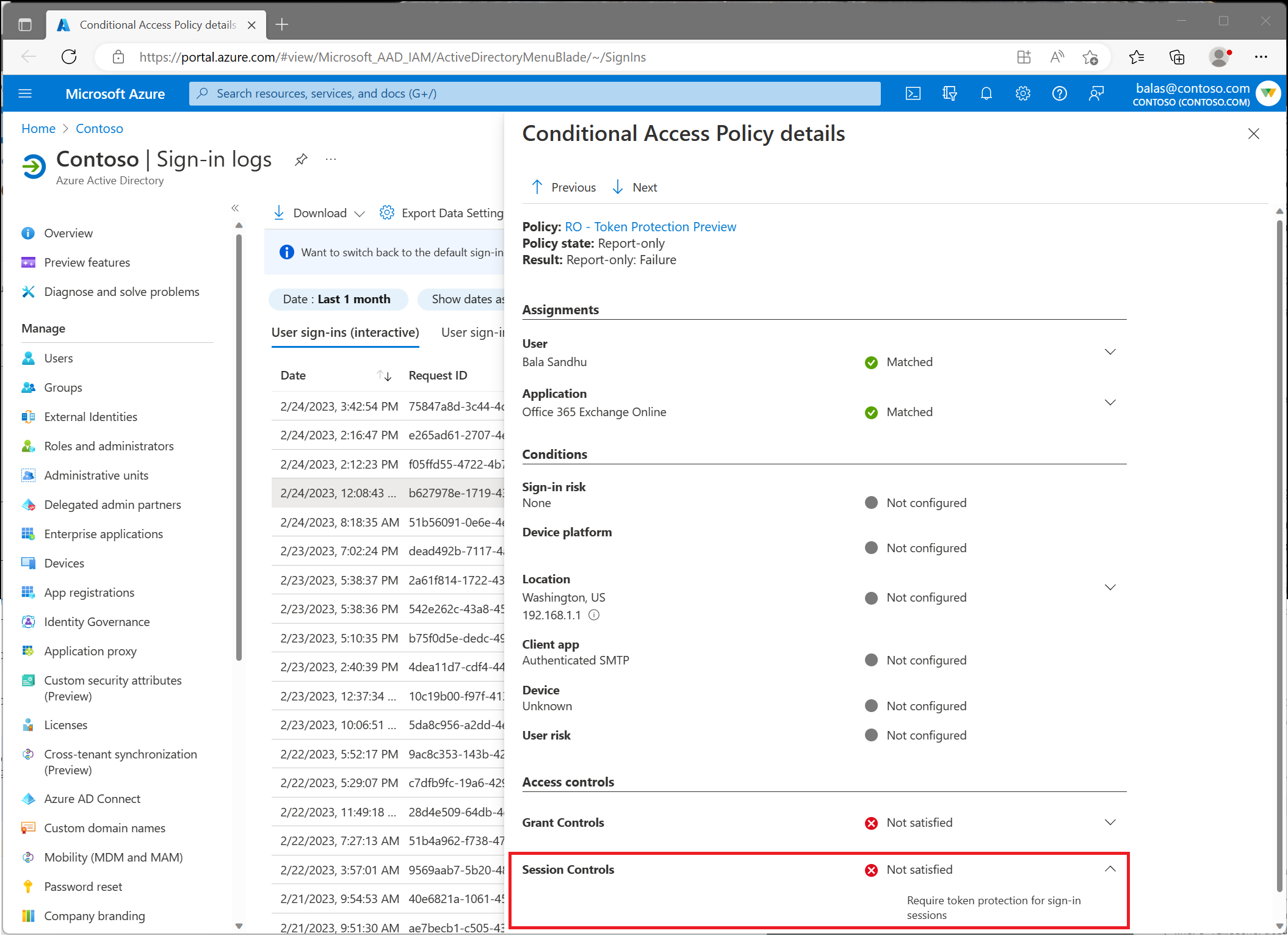Note
Access to this page requires authorization. You can try signing in or changing directories.
Access to this page requires authorization. You can try changing directories.
Token Protection is a Conditional Access session control that attempts to reduce token replay attacks by ensuring only device bound sign-in session tokens, like Primary Refresh Tokens (PRTs), are accepted by Entra ID when applications request access to protected resources.
When a user registers a Windows 10 or later device with Microsoft Entra, a PRT is issued and cryptographically bound to that device. This binding ensures that even if a threat actor steals a token, it can't be used from another device. With Token Protection enforced, Microsoft Entra validates that only these bound sign-in session tokens are used by supported applications.
You can enforce Token Protection policy on Exchange Online, SharePoint Online, and Teams resources. It is supported by many Microsoft 365 native applications. For a comprehensive list of supported applications and resources, please refer to the “Requirements” section.
Note
Use this policy as part of a broader strategy against token theft, as described in Protecting tokens in Microsoft Entra.

Requirements
Using this feature requires Microsoft Entra ID P1 licenses. To find the right license for your requirements, see Compare generally available features of Microsoft Entra ID.
The following devices and applications support accessing resources where a token protection Conditional Access policy is applied:
Supported devices
- Windows 10 or newer devices that are Microsoft Entra joined, Microsoft Entra hybrid joined, or Microsoft Entra registered. See the known limitations section for unsupported device types.
- Windows Server 2019 or newer that are hybrid Microsoft Entra joined.
Note
For detailed steps on how to register your device, see Register your personal device on your work or school network.
Supported applications
- OneDrive sync client version 22.217 or newer
- Teams native client version 1.6.00.1331 or newer
- Power BI desktop version 2.117.841.0 (May 2023) or newer
- Exchange PowerShell module version 3.7.0 or newer
- Microsoft Graph PowerShell version 2.0.0 or newer with EnableLoginByWAM option
- Visual Studio 2022 or newer when using the 'Windows authentication broker' Sign-in option
- Windows App version 2.0.379.0 or newer
The following resources support Token Protection:
- Office 365 Exchange Online
- Office 365 SharePoint Online
- Microsoft Teams Services
- Azure Virtual Desktop
- Windows 365
Known limitations
- Office perpetual clients aren't supported.
- The following applications don't support signing in using protected token flows and users are blocked when accessing Exchange and SharePoint:
- PowerShell modules accessing SharePoint
- PowerQuery extension for Excel
- Extensions to Visual Studio Code which access Exchange or SharePoint
- The following Windows client devices aren't supported:
- Surface Hub
- Windows-based Microsoft Teams Rooms (MTR) systems
- External users who meet the token protection device registration requirements in their home tenant are supported. However, users who don't meet these requirements see an unclear error message with no indication of the root cause.
- Devices registered with Microsoft Entra ID using the following methods are unsupported:
- Microsoft Entra joined Azure Virtual Desktop session hosts.
- Windows devices deployed using bulk enrollment.
- Cloud PCs deployed by Windows 365 that are Microsoft Entra joined.
- Power Automate hosted machine groups that are Microsoft Entra joined.
- Windows Autopilot devices deployed using self-deploying mode.
- Windows virtual machines deployed in Azure using the virtual machine (VM) extension that are enabled for Microsoft Entra ID authentication.
To identify the impacted devices due to unsupported registration types listed previously, inspect the tokenProtectionStatusDetails attribute in the sign-in logs. Token requests that are blocked due to an unsupported device registration type, can be identified with a signInSessionStatusCode value of 1003.
To prevent disruption during onboarding, modify the token protection Conditional Access policy by adding a device filter condition that excludes devices in the previously described deployment category. For example, to exclude:
- Cloud PCs that are Microsoft Entra joined, you can use
systemLabels -eq "CloudPC" and trustType -eq "AzureAD". - Azure Virtual Desktops that are Microsoft Entra joined, you can use
systemLabels -eq "AzureVirtualDesktop" and trustType -eq "AzureAD". - Power Automate hosted machine groups that are Microsoft Entra joined, you can use
systemLabels -eq "MicrosoftPowerAutomate" and trustType -eq "AzureAD". - Windows Autopilot devices deployed using self-deploying mode, you can use enrollmentProfileName property. As an example, if you have created an enrollment profile in Intune for your Autopilot self-deployment mode devices as "Autopilot self-deployment profile", you can use `enrollmentProfileName -eq "Autopilot self-deployment profile".
- Windows virtual machines in Azure that are Microsoft Entra joined, you can use
profileType -eq "SecureVM" and trustType -eq "AzureAD".
Deployment
For users, the deployment of a Conditional Access policy to enforce token protection should be invisible when using compatible client platforms on registered devices and compatible applications.
To minimize the likelihood of user disruption due to app or device incompatibility, follow these recommendations:
- Start with a pilot group of users and expand over time.
- Create a Conditional Access policy in report-only mode before enforcing token protection.
- Capture both interactive and non-interactive sign-in logs.
- Analyze these logs long enough to cover normal application use.
- Add known, reliable users to an enforcement policy.
This process helps assess your users’ client and app compatibility for token protection enforcement.
Create a Conditional Access policy
Users who perform specialized roles like those described in Privileged access security levels are possible targets for this functionality. We recommend piloting with a small subset to begin.
The following steps help you create a Conditional Access policy to require token protection for Exchange Online and SharePoint Online on Windows devices.
- Sign in to the Azure portal as a Conditional Access Administrator, Security Administrator, or Global Administrator.
- Browse to Microsoft Entra ID > Security > Conditional Access.
- Select Create new policy.
- Give your policy a name. We recommend that organizations create a meaningful standard for the names of their policies.
- Under Assignments, select Users or workload identities.
- Under Include, select the users or groups who are testing this policy.
- Under Exclude, select Users and groups and choose your organization's emergency access or break-glass accounts.
- Under Target resources > Resources (formerly cloud apps) > Include > Select resources
Under Select, select the following applications:
- Office 365 Exchange Online
- Office 365 SharePoint Online
- Microsoft Teams Services
- If you deployed Windows App in your environment, include:
- Azure Virtual Desktop
- Windows 365
- Windows Cloud Login
Warning
Your Conditional Access policy should only be configured for these applications. Selecting the Office 365 application group might result in unintended failures. This change is an exception to the general rule that the Office 365 application group should be selected in a Conditional Access policy.
Choose Select.
- Under Conditions:
- Under Device platforms:
- Set Configure to Yes.
- Include > Select device platforms > Windows.
- Select Done.
- Under Client apps:
Set Configure to Yes.
Warning
Not configuring the Client Apps condition, or leaving Browser selected might cause applications that use MSAL.js, such as Teams Web to be blocked.
Under Modern authentication clients, only select Mobile apps and desktop clients. Leave other items unchecked.
Select Done.
- Under Device platforms:
- Under Access controls > Session, select Require token protection for sign-in sessions and select Select.
- Confirm your settings and set Enable policy to Report-only.
- Select create to enable your policy.
After confirming your settings using policy impact or report-only mode, move the Enable policy toggle from Report-only to On.
Tip
Since Conditional Access policies requiring token protection are currently only available for Windows devices, it's necessary to secure your environment against potential policy bypass when an attacker might appear to come from a different platform.
In addition, you should configure the following policies:
Capture logs and analyze
Monitor Conditional Access enforcement of token protection before and after enforcement by using features like Policy impact, Sign-in logs, and Log Analytics.
Sign-in logs
Use Microsoft Entra sign-in log to verify the outcome of a token protection enforcement policy in report only mode or in enabled mode.
- Sign in to the Microsoft Entra admin center as at least a Conditional Access Administrator.
- Browse to Entra ID > Monitoring & health > Sign-in logs.
- Select a specific request to determine if the policy is applied or not.
- Go to the Conditional Access or Report-Only pane depending on its state and select the name of your policy requiring token protection.
- Under Session Controls check to see if the policy requirements were satisfied or not.
- To find more details about the binding state of the request, select the pane Basic Info and see the field Token Protection - Sign In Session. Possible values are:
- Bound: the request was using bound protocols. Some sign-ins might include multiple requests, and all requests must be bound to satisfy the token protection policy. Even if an individual request appears to be bound, it doesn't ensure compliance with the policy if other requests are unbound. To see all requests for a sign-in, you can filter all requests for a specific user or look by corelationid.
- Unbound: the request wasn't using bound protocols. Possible
statusCodeswhen request is unbound are:- 1002: The request is unbound due to the lack of Microsoft Entra ID device state.
- 1003: The request is unbound because the Microsoft Entra ID device state doesn't satisfy Conditional Access policy requirements for token protection. This error could be due to an unsupported device registration type, or the device wasn't registered using fresh sign-in credentials.
- 1005: The request is unbound for other unspecified reasons.
- 1006: The request is unbound because the OS version is unsupported.
- 1008: The request is unbound because the client isn't integrated with the platform broker, such as Windows Account Manager (WAM).
Log Analytics
You can also use Log Analytics to query the sign-in logs (interactive and non-interactive) for blocked requests due to token protection enforcement failure.
Here's a sample Log Analytics query searching the non-interactive sign-in logs for the last seven days, highlighting Blocked versus Allowed requests by Application. These queries are only samples and are subject to change.
Note
Sign In logs output: The value of the string used in "enforcedSessionControls" and "sessionControlsNotSatisfied" changed from "Binding" to "SignInTokenProtection" in late June 2023. Queries on Sign In Log data should be updated to reflect this change. The examples cover both values to include historical data.
//Per Apps query
// Select the log you want to query (SigninLogs or AADNonInteractiveUserSignInLogs )
//SigninLogs
AADNonInteractiveUserSignInLogs
// Adjust the time range below
| where TimeGenerated > ago(7d)
| project Id,ConditionalAccessPolicies, Status,UserPrincipalName, AppDisplayName, ResourceDisplayName
| where ConditionalAccessPolicies != "[]"
| where ResourceDisplayName == "Office 365 Exchange Online" or ResourceDisplayName =="Office 365 SharePoint Online" or ResourceDisplayName =="Azure Virtual Desktop" or ResourceDisplayName =="Windows 365" or ResourceDisplayName =="Windows Cloud Login"
| where ResourceDisplayName == "Office 365 Exchange Online" or ResourceDisplayName =="Office 365 SharePoint Online"
//Add userPrincipalName if you want to filter
// | where UserPrincipalName =="<user_principal_Name>"
| mv-expand todynamic(ConditionalAccessPolicies)
| where ConditionalAccessPolicies ["enforcedSessionControls"] contains '["Binding"]' or ConditionalAccessPolicies ["enforcedSessionControls"] contains '["SignInTokenProtection"]'
| where ConditionalAccessPolicies.result !="reportOnlyNotApplied" and ConditionalAccessPolicies.result !="notApplied"
| extend SessionNotSatisfyResult = ConditionalAccessPolicies["sessionControlsNotSatisfied"]
| extend Result = case (SessionNotSatisfyResult contains 'SignInTokenProtection' or SessionNotSatisfyResult contains 'SignInTokenProtection', 'Block','Allow')
| summarize by Id,UserPrincipalName, AppDisplayName, Result
| summarize Requests = count(), Users = dcount(UserPrincipalName), Block = countif(Result == "Block"), Allow = countif(Result == "Allow"), BlockedUsers = dcountif(UserPrincipalName, Result == "Block") by AppDisplayName
| extend PctAllowed = round(100.0 * Allow/(Allow+Block), 2)
| sort by Requests desc
The result of the previous query should be similar to the following screenshot:
The following query example looks at the non-interactive sign-in log for the last seven days, highlighting Blocked versus Allowed requests by User.
//Per users query
// Select the log you want to query (SigninLogs or AADNonInteractiveUserSignInLogs )
//SigninLogs
AADNonInteractiveUserSignInLogs
// Adjust the time range below
| where TimeGenerated > ago(7d)
| project Id,ConditionalAccessPolicies, UserPrincipalName, AppDisplayName, ResourceDisplayName
| where ConditionalAccessPolicies != "[]"
| where ResourceDisplayName == "Office 365 Exchange Online" or ResourceDisplayName =="Office 365 SharePoint Online" or ResourceDisplayName =="Azure Virtual Desktop" or ResourceDisplayName =="Windows 365" or ResourceDisplayName =="Windows Cloud Login"
| where ResourceDisplayName == "Office 365 Exchange Online" or ResourceDisplayName =="Office 365 SharePoint Online"
//Add userPrincipalName if you want to filter
// | where UserPrincipalName =="<user_principal_Name>"
| mv-expand todynamic(ConditionalAccessPolicies)
| where ConditionalAccessPolicies ["enforcedSessionControls"] contains '["Binding"]' or ConditionalAccessPolicies ["enforcedSessionControls"] contains '["SignInTokenProtection"]'
| where ConditionalAccessPolicies.result !="reportOnlyNotApplied" and ConditionalAccessPolicies.result !="notApplied"
| extend SessionNotSatisfyResult = ConditionalAccessPolicies.sessionControlsNotSatisfied
| extend Result = case (SessionNotSatisfyResult contains 'SignInTokenProtection' or SessionNotSatisfyResult contains 'SignInTokenProtection', 'Block','Allow')
| summarize by Id, UserPrincipalName, AppDisplayName, ResourceDisplayName,Result
| summarize Requests = count(),Block = countif(Result == "Block"), Allow = countif(Result == "Allow") by UserPrincipalName, AppDisplayName,ResourceDisplayName
| extend PctAllowed = round(100.0 * Allow/(Allow+Block), 2)
| sort by UserPrincipalName asc
The following query example looks at the non-interactive sign-in log for the last seven days, highlighting users that are using devices, where Microsoft Entra ID device state doesn't satisfy Token protection CA policy requirements.
AADNonInteractiveUserSignInLogs
// Adjust the time range below
| where TimeGenerated > ago(7d)
| where TokenProtectionStatusDetails!= ""
| extend parsedBindingDetails = parse_json(TokenProtectionStatusDetails)
| extend bindingStatus = tostring(parsedBindingDetails["signInSessionStatus"])
| extend bindingStatusCode = tostring(parsedBindingDetails["signInSessionStatusCode"])
| where bindingStatusCode == 1003
| summarize count() by UserPrincipalName
End user experience
A user that registered or enrolled their supported device doesn't experience any differences in the sign in experience on a token protection supported application when the token protection requirement is enabled.
A user who hasn't registered or enrolled their device and if the token protection policy is enabled sees the following screenshot after authenticating.

A user that isn't using a supported application when the token protection policy is enabled will see the following screenshot after authenticating.



